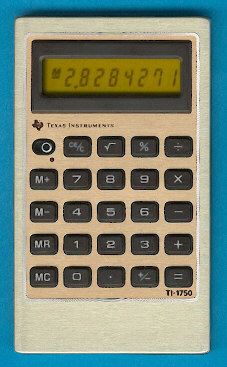
DATAMATH CALCULATOR MUSEUM
 |
DATAMATH CALCULATOR MUSEUM |
Texas Instruments TI-1750 (2nd design)
| Date of introduction: | December 1977 | Display technology: | LCD (yellow) |
| New price: | $19.35 | Display size: | 8 |
| Size: | 4.5" x 2.7" x 0.35" 115 x 68 x 9 mm3 |
||
| Weight: | 2.3 ounces, 65 grams | Serial No: | 119653 |
| Batteries: | 2*LR44 | Date of manufacture: | mth 12 year 1977 |
| AC-Adapter: | Origin of manufacture: | Japan | |
| Precision: | 8 | Integrated circuits: | Toshiba T3603 |
| Memories: | 1 | ||
| Program steps: | Courtesy of: | Stefan Klaes | |
| Download manual: | |
 With
the TI-1750 Texas Instruments entered in 1977 the
market of LCD-calculators. It is very obvious that it wasn’t manufactured by
Texas Instruments. Even the internal construction looks different to typical
Texas Instruments calculators like the later TI-1030.
Which company is really behind the TI-1750? Comparing
the TI-1750 with the Toshiba LC-844
gives the impression that is is a Toshiba design like their OEM calculator Radio
Shack EC-264. Dismantling some TI-1750 from the
Datamath Museum collection gives not only one but five different TI-1750 models:
With
the TI-1750 Texas Instruments entered in 1977 the
market of LCD-calculators. It is very obvious that it wasn’t manufactured by
Texas Instruments. Even the internal construction looks different to typical
Texas Instruments calculators like the later TI-1030.
Which company is really behind the TI-1750? Comparing
the TI-1750 with the Toshiba LC-844
gives the impression that is is a Toshiba design like their OEM calculator Radio
Shack EC-264. Dismantling some TI-1750 from the
Datamath Museum collection gives not only one but five different TI-1750 models:
| Version | Date of manufacture |
Serial No. | Battery | IC |
| 1st | mth 07 year 1977 | 213387 | 3*LR44 | Toshiba T3532 |
| 2nd | mth 12 year 1977 | 119653 | 2*LR44 | Toshiba T3603 |
| 3rd (early) | mth 10 year 1978 | 888828 | 2*LR44 | Toshiba T3709 |
| 3rd (late) | mth 09 year 1979 | 711171 | 2*LR44 | Toshiba T3709 |
| 4th | mth 10 year 1978 | 014178 | 2*LR44 | Sharp LI3023M |
|
• The
1st design use a very complex approach compared to other
LCD-calculators of that era like the Sharp EL-8020. A small detail is the connection between the LCD-contacts and the traces of the PCB. Instead the usual zebra-stripe (an arrangement of conductive and isolation rubber pieces) discrete coil springs are used. • The 2nd design still uses discrete coil springs to connect the LCD-contacts with the PCB traces but uses a smaller calculator chip in a 43-pin QFP (Quad Flat Pack) housing. • The 3rd design uses a much simpler approach and shows a huge cost reduction. It resembles the typical style of LCD-calculators sold in 1978. A funny detail is the battery holder accommodating two coin cells and one plastic dummy battery! • Later models of the 3rd design corrected this flaw and modified the battery holder down for two cells. • The 4th design looks nearly identical but uses different parts. The internal plastic frame of the housing and the printed circuit board were changed to use a Sharp calculator brain instead the Toshiba chips found in the other versions. From outside you notice the different position of the LC-display and the shape of the display frame. |
There
are different rumors which companies designed and manufactured the TI-1750,
usually you get Toshiba and Sharp.
Comparing the 4 versions with similar calculators manufactured by Sharp we could
reject this speculation. On the other hand we can’t believe that Toshiba used
a calculator chip from competitor Sharp.
Searching
all parts for a hint to possible manufacturers gives you the Sansyu
logo.
If you have additions to the above article please email: joerg@datamath.org.
© Joerg Woerner, December 14, 2002. No reprints without written permission.